
The accolade (also known as dubbing or adoubement) (Latin : benedictio militis) was the central act in the rite of passage ceremonies conferring knighthood in the Middle Ages. [1] [2] [3] [4]

The accolade (also known as dubbing or adoubement) (Latin : benedictio militis) was the central act in the rite of passage ceremonies conferring knighthood in the Middle Ages. [1] [2] [3] [4]
The term accolade entered English by 1591, when Thomas Lodge used it in a historical romance about Robert the Devil: "He had with all solemnitie the accolade, and was commanded to kneele downe to receiue the order of Knighthoode." It derives from the Middle French accolee, meaning an embrace or the bestowal of knighthood thereby, which in turn descends from the Latin collum, meaning "neck". [5]

Accolade ceremonies have taken a variety of forms, including the tapping of the flat side of a knighting sword on the shoulders of a candidate (who is himself sometimes referred to as an accolade during the ceremony) [1] [6] or an embrace about the neck.[ citation needed ]
The earliest reference to the knighting as a formal ceremony in Germany is in the Annals of Aachen under the year 1184, when the Emperor Frederick I's sons, Henry VI and Frederick VI, "were made knights" (facti sunt milites). [7]

An early Germanic coming-of-age ceremony, of presenting a youth with a weapon that was buckled on him, was elaborated in the 10th and 11th centuries as a sign that the minor had come of age. A panel in the Bayeux Tapestry shows the knighting of Harold by William of Normandy, but the specific gesture is not clearly represented.
In medieval France, early ceremonies of the adoubement were purely secular and indicated a young noble coming of age. Around 1200, these ceremonies began to include elements of Christian ritual (such as a night spent in prayers, prior to the rite ). [8]
The increasingly impressive ceremonies surrounding adoubement figured largely in the Romance literature, both in French and in Middle English, particularly those set in the Trojan War or around the legendary personage of Alexander the Great. [9]

Newly inducted military Knights of the Legion of Honour are struck on both shoulders with a sword (Army and Navy) or a dirk (Air Force), if the ceremony is presided over by a military authority. [10] Civilian members and all members of lesser orders (Merit, Arts and Letters...) are not dubbed with a bladed weapon. They receive only the accolade, which has kept in French its ancient meaning of "embrace".
Officers in the French Armed Forces also receive the accolade, but a different version. When they graduate, during the ceremony a senior officer hovers their sword on the kneeling graduate's shoulders as if he were knighting the young officer. This part is called the "adoubement", which has a different meaning than accolade. Adoubement involves the sword, accolade is a movement of the hands which varies in different countries. In France, it can be akin to a hug or a hand on the shoulder.
In the Netherlands, the knights in the exclusive Military Order of William (the Dutch "Victoria Cross") are struck on the left shoulder with the palm of the hand, first by the Dutch monarch (if present) then by the other knights. The new knight does not kneel. [11]
All newly created knights in the UK are dubbed on both shoulders with a sword by the monarch or the prince delegated by them. In the first example, the "knight-elect" kneels in front of the monarch on a knighting-stool. [1] First, the monarch lays the side of the sword's blade onto the accolade's right shoulder. [1] The monarch then raises the sword just up over the apprentice's head, flips it counterclockwise so that the same side of the blade will come in contact with the knight's body, and places it on his left shoulder. [1] The new knight then stands up, and the king or queen presents him with the insignia of his new order. Contrary to popular belief, the phrase "Arise, Sir ..." is not used. [12] There are currently eleven different knighthoods being bestowed (in ascending order): Knights Bachelor, Knights Commanders and Knights Grand Cross of the Order of the British Empire, Royal Victorian Order, Order of Saint Michael and Saint George and Order of the Bath, Knights of the Order of the Thistle and Knights Companion of the Order of the Garter.
Women who are awarded damehoods do not receive the accolade. [13]
Clergy receiving a knighthood are not dubbed. The use of a sword in this kind of a ceremony is believed to be inappropriate. [1]
Knights of the Equestrian Order of the Holy Sepulchre of Jerusalem, an Order of chivalry under the protection of the Holy See, are dubbed in the head and on both shoulders during the investiture ceremony. The accolade is given during Holy Mass, by the officiating Prelate.
The accolade is also performed today with the unrecognized Habsburg Order of St. George during the investiture with a sword on both shoulders. The ceremony including the oath is performed by Karl von Habsburg or Georg von Habsburg. The knights kneel and the sword touches both shoulders. [14] [15]
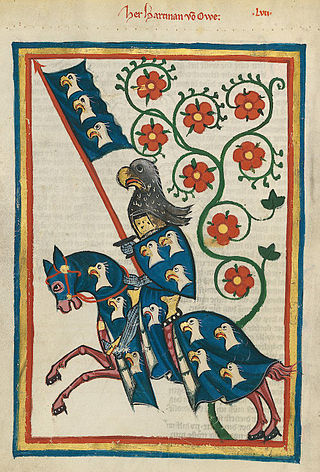
A knight is a person granted an honorary title of knighthood by a head of state or representative for service to the monarch, the church or the country, especially in a military capacity.
In the United Kingdom and the British Overseas Territories, personal bravery, achievement, or service are rewarded with honours. The honours system consists of three types of award:

Chivalry, or the chivalric language, is an informal and varying code of conduct developed in Europe between 1170 and 1220. It is associated with the medieval Christian institution of knighthood, with knights being members of various chivalric orders; knights' and gentlemen's behaviours were governed by chivalrous social codes. The ideals of chivalry were popularized in medieval literature, particularly the literary cycles known as the Matter of France, relating to the legendary companions of Charlemagne and his men-at-arms, the paladins, and the Matter of Britain, informed by Geoffrey of Monmouth's Historia Regum Britanniae, written in the 1130s, which popularized the legend of King Arthur and his knights of the Round Table.

The Most Noble Order of the Garter is an order of chivalry founded by Edward III of England in 1348. The most senior order of knighthood in the British honours system, it is outranked in precedence only by the decorations of the Victoria Cross and the George Cross. The Order of the Garter is dedicated to the image and arms of Saint George, England's patron saint.

The Most Honourable Order of the Bath is a British order of chivalry founded by King George I on 18 May 1725. The name derives from an elaborate medieval ceremony for preparing a candidate to receive his knighthood, of which ritual bathing was an element. While not all knights went through such an elaborate ceremony, knights so created were known as 'knights of the Bath', and likely from the upper classes.

The Distinguished Order of the Golden Fleece is a Catholic order of chivalry founded in Bruges by Philip the Good, Duke of Burgundy, in 1430, to celebrate his marriage to Isabella of Portugal. Today, two branches of the order exist, namely the Spanish and the Austrian Fleece; the current grand masters are King Felipe VI of Spain and Karl von Habsburg, head of the House of Habsburg-Lorraine, respectively. The Grand Chaplain of the Austrian branch is Cardinal Christoph Schönborn, Archbishop of Vienna.

The Equestrian Order of the Holy Sepulchre of Jerusalem, also called Order of the Holy Sepulchre or Knights of the Holy Sepulchre, is a Catholic order of knighthood under the protection of the Holy See. The Pope is the sovereign of the order. The order creates canons as well as knights, with the primary mission to “support the Christian presence in the Holy Land.” It is an internationally recognised order of chivalry. The order today is estimated to have some 30,000 knights and dames in 60 lieutenancies around the world. The Cardinal Grand Master has been Fernando Filoni since 2019, and the Latin Patriarch of Jerusalem is ex officio the Order's Grand Prior. Its headquarters are situated at the Palazzo Della Rovere and its official church in Sant'Onofrio al Gianicolo, both in Rome, close to Vatican City. In 1994, Pope John Paul II declared the Virgin Mary as the order's patron saint under the title "Blessed Virgin Mary, Queen of Palestine."
The fount of honour is a person, who, by virtue of their official position, has the exclusive right of conferring legitimate titles of nobility and orders of chivalry on other persons.
Investiture is a formal installation or ceremony that a person undergoes, often related to membership in Christian religious institutes as well as Christian knighthoods or damehoods, in addition to government offices.

The Royal Order of the Sword is a Swedish order of chivalry and military decoration created by King Frederick I of Sweden on 23 February 1748, together with the Order of the Seraphim and the Order of the Polar Star. The motto of the order is in Latin: Pro Patria.
A dynastic order, monarchical order, or house order is an order under royal patronage. Such an order is bestowed by, as a legitimate fons honorum, a sovereign or the head of a once-sovereign ruling family. These are often considered part of the cultural patrimony of the ruling family. Dynastic orders were often founded or maintained to reward service to a monarch or their subsequent dynasty.
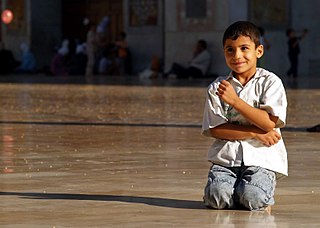
Kneeling is a basic human position where one or both knees touch the ground. Kneeling is defined as “to position the body so that one or both knees rest on the floor,” according to Merriam-Webster. Kneeling when only composed of one knee, and not both, is called genuflection.

The Royal Order of the Seraphim is a Swedish order of chivalry created by King Frederick I on 23 February 1748, together with the Order of the Sword and the Order of the Polar Star. The order has only one class with the dignity of Knight, and is the foremost order of Sweden.

An order of chivalry, order of knighthood, chivalric order, or equestrian order is an order of knights, typically founded during or inspired by the original Catholic military orders of the Crusades and paired with medieval concepts of ideals of chivalry.
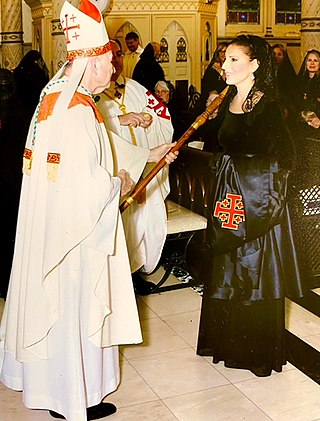
Dame is an honorific title and the feminine form of address for the honour of damehood in many Christian chivalric orders, as well as the British honours system and those of several other Commonwealth realms, such as Australia and New Zealand, with the masculine form of address being Sir. It is the female equivalent of a knighthood, which is traditionally granted to males. Dame is also a style used by baronetesses in their own right.

The Ordre du Croissant was a chivalric order founded by Charles I of Naples and Sicily in 1268. It was revived in 1448 or 1464 by René I, king of Jerusalem, Sicily and Aragon, to provide him with a rival to the English Order of the Garter. René was one of the champions of the medieval system of chivalry and knighthood, and this new order was neo-Arthurian in character. Its insignia consisted of a golden crescent moon engraved in grey with the word LOZ, with a chain of 3 gold loops above the crescent. On René's death, the Order lapsed.

Passage fee is a donation given by a newly dubbed knight in celebration of his investiture into the knighthood. During the Crusades, passage fees, known as droit de passage, were used to cover the cost of travel to the Holy Land. The passage fee is still present in some modern chivalric orders, such as the Order of the Holy Sepulchre. In the medieval era, the passage fee for the Knights Hospitaller was around 360 Spanish pistoles.
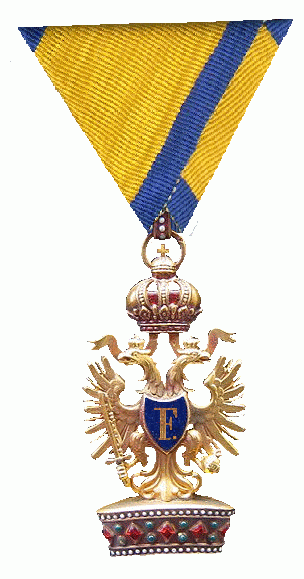
The Imperial Order of the Iron Crown was one of the highest orders of merit in the Austrian Empire and Austria-Hungary until 1918. It was founded in 1815 by Emperor Franz I of Austria as a re-establishment of the original Order of the Iron Crown, which previously had been an order of the Napoleonic Kingdom of Italy.

The Order of Saint George is an Austrian chivalric order founded by the Habsburg emperor Frederick III and Pope Paul II in 1469. Established as a military order to advocate the Christian faith, its original implicite goal was to combat the Ottoman incursions into the Inner Austrian lands of Styria, Carinthia and Carniola. The order resided at Millstatt Abbey and in Wiener Neustadt, until in 1598 its properties were handed over to the Jesuit college in Graz.
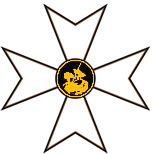
The Order of St. George – a European Order of the House of Habsburg-Lorraine, or simply Order of Saint George, is a dynastic order of chivalry and thus a house order of the House of Habsburg-Lorraine, the former Imperial and Royal House of the Holy Roman Empire, the Habsburg monarchy, the Empire of Austria, the Austro-Hungarian Monarchy, the Kingdom of Hungary, the Crown lands of Bohemia and Kingdom of Croatia-Slavonia and further nations.
{{cite web}}: CS1 maint: unfit URL (link)